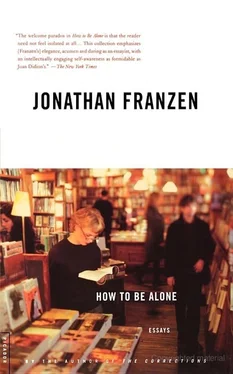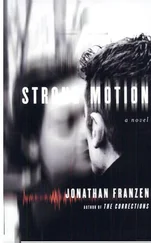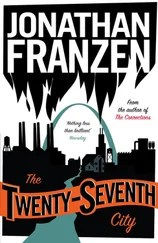What’s futuristic about ADX and CSP is not their high-tech accoutrements (you won’t see the exoskeletal uniforms or blaster guns of sci-fi flicks) but the social context in which these facilities are coming on line. It isn’t hard to extrapolate the logic of our political economy’s solution to the crime problem. In many respects, the future is glimpsable in our not wholly unpleasant present. The murder rate is plummeting in New York City, for example, as New York State’s prison population soars. Three-quarters of the inmates in the state system come from just seven impoverished neighborhoods in New York City. Apparently it’s genuinely feasible simply to lock away the problem. Across the country, educational programs for inmates are on the wane, executions are mounting, and more and more legislators are clamoring to reduce recreation for prisoners and to extract greater revenues from prison labor.
The black or Latino youth whose father is in prison and whose neighborhood can offer no better job than bagging groceries commits a crime, is processed, and is then shipped to a warehouse in a rural white community. Between strikes one and three there’s a cynical calculus: the imprisoned youth emerges from jail embittered and unemployable; inevitably, he commits another crime; inevitably, there are innocent victims. Residual crimes are the cost of doing business in this country, and even these pay the dividend of keeping the public’s fear of crime ever fresh.
The social Darwinist may here ponder the beauties of our economy’s evolution. The press covers crime (especially the relatively rare instances of random violence against white people) because crime sells — because the white audience loves to hear about it. Then the intensive, decontextualized, and highly salable coverage of crime becomes evidence of a Crime Epidemic; the Audience gets “sick and tired” of hearing about a thing that every marketer knows it actually never gets sick or tired of hearing about, and it empowers its elected representatives to Get Tough. Thus the criminal is demonized. The distance between Us and Him grows and grows, thereby ensuring that here in the country that invented the Western and the crime drama and the News at Eleven, in the country that celebrated the James brothers and Bonnie and Clyde, we will always be able to hear what we most don’t want to hear, which is what we most want to hear. In enjoying and then punishing our murderers, we are continually trying to exorcise the contradictions that make us Americans. Our love-hate love affair with crime is the epos of the controlling dollar at war with the wild frontier.
Eventually, when the black or Latino youth whiffs at his third spitball, he’s remanded for life to a system that maintains internal order and earns money by forcing its prisoners to do, for a dollar or less per hour, the menial work that as free men they refused to do for a minimum wage. For the men who won’t cooperate, there’s always a stint in dispensaries of benevolent discipline like ADX and CSP. At first hearing, Ray Levasseur’s description of ADX as a “proto-techno-fascist’s architectural wetdream” sounds like tired agitprop hyperbole. But consider fascism in its original (Italian) sense of getting government to work with the bloodless efficiency of a corporation; of making the trains run on time. Fascism’s real essence is a patriotic corporatism that presents itself as beneficent and effective. In light of the future we are building in Fremont County, Ray Levasseur and Mutulu Shakur, whose claims of being “political” make them anomalies, are actually the system’s most typical prisoners. It may be true that each of the individuals in our nation’s prisons represents a story of personal irresponsibility. But the whole of a million and a half of these stories is greater than the sum of its parts. The whole is political, and Levasseur and Shakur are the voice of the statistics. They are saying, Let’s think about what a million and a half men in jail might imply about the way we do business.
And here is the thing: the Feds aren’t friendly to me, their reserve won’t thaw. Whereas every Coloradan I speak to is a person of visible hopes, dreams, fears. It takes me only an hour to love them. They are not positive of anything. They seem at once freer and more captive than the federal functionaries who by day are sealed inside their compound and by twilight commute to Pueblo West. Free to be confused and suspicious, and captive to the perpetually self-perfecting mechanisms of control and cash flow that are stalking the last of America’s traditional communities. Captive to the federal agency that allows a town to hope for construction jobs that don’t materialize, promises three prisons and throws in an Alcatraz as an afterthought, hints at trade with local businesses but ends up using prearranged suppliers; captive to the inescapable efficiency of strip malls and tract housing. There’s no conspiracy here, no conscious intent to deceive, no grand ironies. There’s only, in this valley of erosional mesas and spent mines, the stepwise dwindling of an innocence. When Merle Strickland says that her community’s greatest asset is its water rights and not its people, she’s both exactly right and exactly wrong.
At night the prisons glow in the desert like a reactor, a launchpad, some latent federal thing. From miles away you can see that nothing’s moving inside the wire.
[1995]
In the erotic broadsheets of the New York Times , which every morning lies on my breakfast table, silently awaiting my attentions, there recently appeared what seemed to me a wholly reasonable op-ed piece by Adam Hochschild on the horror of airport television. “At gates cursed with the TV’s,” Hochschild wrote, “most of the passengers are trying to talk, work or read. But the penetrating TV noise needles itself into the conversations and onto the pages.” His complaint soon brought replies from the Refiners, Resonators, and Rebutters who typically write letters to the Times . One Refiner suggested that airport TVs might play silently with captions. One Resonator wrote movingly of the kindred horror of “smelling and hearing popcorn” in movie theaters; another invited readers to “try spending a night in any moderately priced hotel without enduring the buzz-muffle of televised talk.” (The rage palpable in the word “buzz-muffle”! Nothing more reliably bolsters my faith in humanity than the dyspepsia of letters to the Times ) There was also, however, a classic Rebuttal from the president of Turner Private Networks, who claimed, bizarrely, that airport TV is “not intrusive” and, more persuasively, that Hochschild is “more alone than he might think.” Apparently, Nielsen surveys show that ninety-five percent of air travelers believe that television enhances the airport environment, and eighty-nine percent believe that “it makes the time spent in an airport more worthwhile.” I pitied Hochschild when I read this. Here he is, trying bravely to give voice to a silent majority of sufferers, hoping to incite communal outrage, when along comes somebody with a figure— ninety-five percent —to knock his legs out from under him. He’s mugged by a norm.
This business of norms, which are a fixture of the information age — as friends or as tyrants, depending on how normal you are — was on my mind this winter when I embarked on a survey of contemporary popular sex books and was confronted with evidence that I am one of the few heterosexual men in America who’s not turned on by elaborate lingerie. In bookstores, pop-sex books are usually shelved under Health (a topic of such importance to the culture that every book now published, including novels, could arguably be shelved there), and, since sexual “health” is impossible to define objectively, they offer the reader a uniquely rich array of normative pronouncements. “Matching lacy bra and panties, garter belt and stockings, bustiers, G-strings, and teddies — most men can’t get enough of this stuff,” Sydney Biddle Barrows, the Mayflower Madam, writes in Just Between Us Girls . She later adds: “Whatever the reason, bustiers and merry widows seem to be almost universally popular garments.” Dr. Susan Block, in The 10 Commandments of Pleasure , commands the female reader, “Wear lingerie,” and explains that “men who love sex love a woman who thinks about it, dresses up for it.” Susan Crain Bakos, the author of Sexational Secrets , concurs: “Men love it when you come to bed in high heels, bustier, and stockings.” Lest these generalizations seem unscientific, the authors of Sex: A Man’s Guide report that, according to their survey of Men’s Health readers, lingerie is “without a doubt. . the U.S. male’s favorite erotic aid.”
Читать дальше
Конец ознакомительного отрывка
Купить книгу












